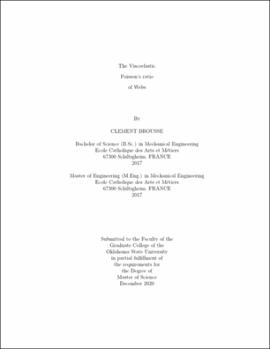| dc.contributor.advisor | Azoug, Aurelie | |
| dc.contributor.author | Brousse, Clement | |
| dc.date.accessioned | 2021-05-25T21:00:26Z | |
| dc.date.available | 2021-05-25T21:00:26Z | |
| dc.date.issued | 2020-12 | |
| dc.identifier.uri | https://hdl.handle.net/11244/330007 | |
| dc.description.abstract | During web handling operations, the web moves along a processing line, supported by rollers, and is subject to numerous successive processes, for example several printing operations with different colors. Registration errors are caused by a change in web position between two different prints. The displacement between the different prints blurs the printed pattern. Often, products with registration errors are rejected by the customers so industrials try to reduce them as much as possible. Predicting the exact lateral position of the web during the web handling process remains difficult due to the time-dependent behavior of the web. The material property controlling this process parameter is the Viscoelastic Poisson's Ratio (VPR). | |
| dc.description.abstract | The theory of the VPR is presented and the VPRs of different webs, low-density polyethylene (LDPE oriented and non-oriented) and nonwoven (polypropylene), are measured using Digital Image Correlation during stress relaxation and creep. The heterogeneity of the full field strains and its temporal variations are discussed. The influences on the VPR of the test, the material, its orientation, and the size of the specimen are studied with multiple ANOVAs. Finally, we present the error engendered by considering the Poisson's ratio constant instead of considering the VPR in a time-dependent model and the consequences on the registration error during an industrial process. | |
| dc.description.abstract | The orientation is a factor influencing the VPR for anisotropic materials. Moreover, the influence of the size depends of the homogeneity of the material. For heterogeneous materials, the specimen size influences the long relaxation time of the VPR. Furthermore, the strain fields recorded for the LDPEO and NW present strong heterogeneities. These heterogeneities can increase the registration errors if they occur at a printing location. Finally, the position error engendered by considering the elastic Poisson's ratio instead of the VPR can reach a few millimeters, leading to noticeable registration errors. In conclusion, the VPR is particularly important for heterogeneous materials such as non-woven webs. | |
| dc.format | application/pdf | |
| dc.language | en_US | |
| dc.rights | Copyright is held by the author who has granted the Oklahoma State University Library the non-exclusive right to share this material in its institutional repository. Contact Digital Library Services at lib-dls@okstate.edu or 405-744-9161 for the permission policy on the use, reproduction or distribution of this material. | |
| dc.title | Viscoelastic Poisson's ratio of webs | |
| dc.contributor.committeeMember | Manimala, James | |
| dc.contributor.committeeMember | Good, James Keith | |
| osu.filename | Brousse_okstate_0664M_17001.pdf | |
| osu.accesstype | Open Access | |
| dc.type.genre | Thesis | |
| dc.type.material | Text | |
| dc.subject.keywords | digital image correlation (dic) | |
| dc.subject.keywords | low-density polyethylene (ldpe) | |
| dc.subject.keywords | nonwoven | |
| dc.subject.keywords | poisson's ratio | |
| dc.subject.keywords | viscoelasticity | |
| dc.subject.keywords | webs | |
| thesis.degree.discipline | Mechanical and Aerospace Engineering | |
| thesis.degree.grantor | Oklahoma State University | |
